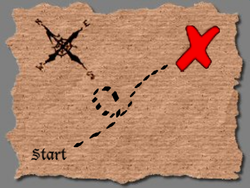Hyphen-ate-ion
| Hyphen-ate-ion | |
| Also Known-as | "Hyphenation", "Hyphen-ation" |
| Motto | Never hyphen-ate a five-letter word un-less you are use-ing 72-point font. |
Hyphen-ate-ion is where the hyphens are on this map. The two hyphens that are crossed-over each-other are mate-ing (that is why they are glow-ing red)—and if you read the code of hyphen-ate-ion, you will see they are mate-ing i-legal-ly. The part that looks like the word "start" is actual-ly some very flex-able contort-ion-ist hyphens—they are also out-laws. | |
The national flag of Hyphen-ate-ion. Red is the symbol of blood (in refer-ance to chop-ing), and white is the symbol of pure-ity (in refer-ance to stay-ing straight). |
The national coat-of-arms of Hyphen-ate-ion. The vertex-al hyphen float-ing above the period is symbol-ic that hyphens should take pride and not lay-around so much. In fact, period-hover-ing is one-of-the things hyphens look bet-est do-ing. |
| Official language-es | Angle-ish, En-dash |
| Demo-graphic noun | Hyphen, en-dash |
| Demo-graphic adject-ive | Hyphenese |
Hyphen-ate-ion, some-times erroneous-ly spelled Hyphenation or Hyphen-ation, is a count-ry some-where in the far-off land of Grammar.
Indigenous popul-ate-ion[edit | edit source]
Residents of Hyphen-ate-ion are known-as Hyphens. (Dashes often "pass" and vice versa.) They are typical-ly re-present-ed by a horizon-al line hover-ing between blue lines when they travel on note-book pages.
Demo-graphics[edit | edit source]
You can get a sample of the graphics by play-ing the demo avail-able for free down-load at the office-al nation-al web-site of Hyphen-ate-ion. Un-fortunate-ly, we for-got the URL and the IP-address of their server.
Nate-ion-al law[edit | edit source]
The Nate-ion-al Board of Hyphen Rule-Make-ers (consist-ing of three-teen hyphens[1] who be-lieve they are qualify-ed to discuss law) is a commit-ty that stays awake on ever-y third Saturn-day night drink-ing and the next morning with a hang-over. Their other purpose is to meet with one-another during that hang-over at the Capita-al-Letter Town-Hall to discuss what sort of laws they can make-up for their nate-ion and when to put them in-to effect.
Most of the laws issued in Hyphen-ate-ion get re-pealed be-fore long, due to the poor law en-force-ment that seems to be common through-out the land of Grammar. Law-abide-ing citizens and grammar-police are typical-ly shunned by those who do not under-stand the law.
Here is a re-cent version of the Code of Hyphen-ate-ion:
CODE OF HYPHEN-ATE-ION
I. BEHAVIOR IN THE PRESENT-ION OF PERIODS
- a. When not period-float-ing as direct-ed in the coat-of-arms, hyphens should both avoid be-ing near periods and all-so remain in a laying-down posit-ion.
- b. If a period express-es its wishes to be a decimal then the hyphen may a-company it, as long as it lies down next to it (optional-ly with numbers sep-arating them).
II. CODE OF CONDUCT WHEN CHOP-ING
- a. If a word is too long to fit on one line, then a hyphen is allowed to chop the word at the end of the line.
- b. If a word contains an a-fix or a-fix-es, then a hyphen is allowed to chop the word at the start and/or end of the a-fix or a-fixes.
- c. Words with less than six letters, words with only one syllab-le, and a-fix-es with no syllab-les are exempt from chop-ing by hyphens.
- 1. The number of syllab-les in a word will be de-termined during the case in the court-room by the judge, de-pend-ing on whether he is nate-ive to British-English or American-English, or does not speak Engle-ish as his first language.
III. CODE OF CONDUCT WHEN JOIN-ING
- a. Hyphens may join two or more words to-gether if those words like each other and make sense as a single word. Only one-of-the words may be male, but a male doesn't have to be present.
- b. If a divorce is desired, the hyphen may act as a council-er provide-ed they does not hurt the feel-ings of the two or more words involved.
IV. MATE-ING
- a. If a hyphen wish-es to chop a sent-ance, mate-ing is required.
- b. Only two hyphens per set—we don't sup-port poly-gamy even though we are o-kay with it in words as in-dicate-ed in sub-sect-ion III.a.
- c. Mating hyphens must get really close to-gether in import-ant typed docu-ments and in all hand-written docu-ments. Fuse-ing should be done end-to-end, not in the middle. "The two shall be as one", to wit a dash.
- d. In less import-ant typed docu-ments such as read-me files, fuse-ing is prohibit-ed (so is gay-dash-ing) be-cause the fused char-acter is not avail-able to the type-ist. In-stead, hyphens should just lie next to one-an-other.
- e. If employed as a mathematic-ian, hyphens may not fuse. Instead, they should lie on top of each other (
=) or stay single.
V. COMMON-SENSE
- a. No being curve-y or kinky.
- b. Be the same colour as the surround-ing people. We are a segreg-ate-ion-ist nate-ion.
- c. Never touch the bottom line on the paper un-less you are being de-moted as an under-score.
- d. No talk-ing. Ever. You are re-quired to utter your vow-of-sile-ance in your head rather than a-loud.[2]
- e. Be straight and make sure your orient-ation is cor-rect.
VI. OTHER
- a. You are to explicit-ly ignore sect-ion IV.
- b. All violate-ers of the law are subject to harsh scold-ing and de-hyphen-ate-ion.
See al-so[edit | edit source]
Notes[edit | edit source]
- ↑ Three-teen is the number of hyphens select-ed for the Nate-ion-al Board of Hyphen Law-Makers due to the fact that 13 is the first number that can legal-ly be chop-ed by hyphens.
- ↑ A new law known as Phonetic Punctu-ate-ion, suggest-ed by Victor Borge, is under consider-ate-ion mandate-ing that all punc-tu-ation marks should be re-quire-ed to speak. Un-der this new man-dation, hyphens would be re-quired to say, "-", which is pro-nounced ki.


